Where to Stay in Lisbon: A Complete Guide for First Timers
Lisbon was both our first stop in Portugal, and was also our last stop in Europe a couple of months later when our 89 days in Europe were up (that’s just shy of the 90 day maximum we can spend in the E.U. on a tourist visa).
We really enjoyed Lisbon, and spent the better part of a week wandering the streets of Lisbon’s neighborhoods, stopping here and there for a cup of coffee or a glass of Portuguese wine – which is both cheap and delicious – the two best wine tasting notes, in our opinion.
Lisbon is a city not unlike San Francisco, our former home, in that each neighborhood has a distinct look, style, and overall vibe.
As you walk from the cosmopolitan grid that is Baixa, Lisbon’s downtown, towards the narrow, winding cobblestone streets in Alfama, the oldest-feeling part of the city, you’ll understand what we mean.
The areas are a few short blocks apart, but couldn’t look and feel more different.
Once you begin to understand the history of Lisbon, you’ll start to understand why. We’re obviously not Lisbon history experts, but we did a couple of walking tours and connected with locals who are.
Our Drunk History (if you’re not familiar, it’s a tv show where they film someone simultaneously telling a story about a historical event and getting wasted at the same time – it’s really fun!) take on the reason that Lisbon’s neighborhoods look and feel so different is that, after the earthquake in the 18th Century, the city brought in various architects from different places around the world to help rebuild and replan the city.
As a result, you have parts of the city that look like Paris, with grand boulevards lined with four story apartment buildings, and parts of the city that feel like Ancient Rome, with cobblestone streets and castles.
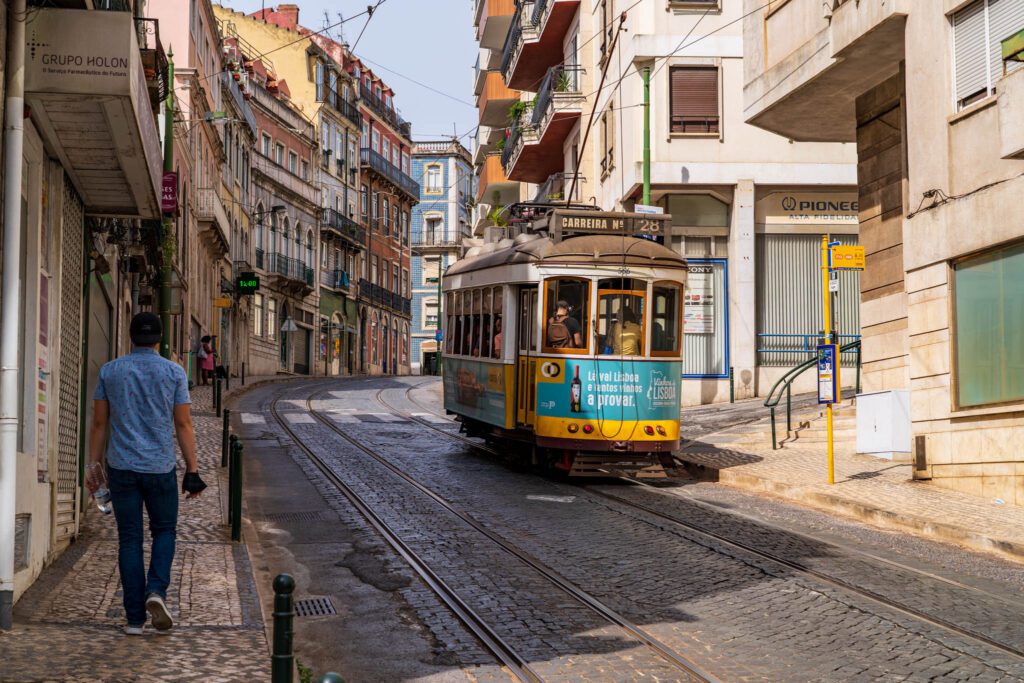
We recognize that our idea of the best place to stay in Lisbon might not be the same as yours, so we set out to write a comprehensive guide that takes you through a few of our top picks and helps you figure out whether or not each area is right for you.
In this guide to figuring out where to stay in Lisbon for your particular style and budget, we’ll go through our favorite neighborhoods, along with the pros and cons of staying there, some highlights that you probably shouldn’t miss (whether or not you choose to stay there), and some recommended hotels, apartments, and hostels to get you started on your search.

Disclaimer: Some of the links in this post, like hotel links, are affiliate links, meaning at no additional cost to you, we make a little bit of money if you click through and book. That being said, we would never recommend something to you that we don’t stand behind 100%.
Where to Stay in Lisbon: The 4 Best Places to Stay
Now that you’ve gotten a brief overview of Lisbon’s layout, let’s get into the specific places to stay in Lisbon that we like.
Of course, like most cities, the answer to the question “where should I stay in Lisbon?” largely depends on YOU and your preferences.
There’s no cookie-cutter answer that we can give you. Which is why we’re going into the pros and cons of each area below to give you an idea of whether or not it fits what you’re looking for.
Our philosophy when it comes to deciding on a place to stay is to first choose the neighborhood, then move on to finding a great hotel, hostel, or apartment in that area.
The reality is that, depending on what you’re looking for, there are other neighborhoods not included in this guide that might meet your needs. But these are the four that we think are the best for 99% of travelers, and we’ve shown our work, doing our best to explain why we think that.
For each of the neighborhoods below, we’ve created a structure to help you figure out if it’s the right home base for you.
Here’s what we’ll cover:
- An overview of the neighborhood and our experience with it. We’ve personally been to and explored (more than once) all of the areas on this list, so we’ll try to give you a little bit of our perspective on what makes each area special.
- Pros and cons of staying in this area. The things you need to know to make your decision.
- Highlights of the neighborhood. Coffee shops, restaurants, parks, etc that we enjoyed, and think you probably will too.
Now, we’re well aware that a few of you are currently ready to throw your left shoe at the screen, saying “I don’t have time to read all of that, JUST TELL ME THE BEST PLACE TO STAY!”
Well, here’s a quick summary of this guide if you’re short on time (though we’d recommend reading the section of the place you end up staying for tips and places to add to your list!).
Our overall recommendation is to stay in Chiado, which is a great combination of central location, charm, and places to eat and drink. We loved this part of the city, and it’s basically the centerpoint between all of our favorite neighborhoods in Lisbon. Our friends are staying at the beautiful Casa do Barao, a gorgeous hotel in a perfect location (with a rooftop pool!). If you’re looking for a more affordable stay, look at Feeling Chiado 15 or Chiado 44, two charming, mid-range guesthouses in the heart of Chiado.
If you’re looking for a more affordable option, stay at the base of Lisbon’s many hills in modern Baixa (near Rossio Square). It lacks the charm of the rest of the city (it’s very modern and well-planned, which isn’t the case for the hills), but the location is great for getting around (on foot or on public transit), and the prices are reasonable. Our top hotel pick here is My Story Hotel Figueira, which is right on a beautiful square a few blocks from Rossio station (where you’ll catch the train for a day trip to Sintra). We stayed at Porto do Mar Apartments in Baixa, which we recommend (for the price and location), but would choose the Visionaire Apartments (which are around the corner from the hotel we mentioned above) for our next trip.
If you want to stay in the most romantic part of the city, you should stay in Alfama. This part of the city is all narrow streets and excellent views out over the city. Plus, a few of our favorite spots to eat and drink are in the neighborhood (don’t miss Miss Can!). It’s a pain to get to, though, since it’s on top of a big hill with limited transit options. The hotel options here are limited, and we’d opt for the Convento do Salvador for a unique stay in a former convent.
Where We’ve Stayed in Lisbon
The best place to start this guide is our own personal experience. We found ourselves in Lisbon twice in the span of a couple of months, and stayed in slightly different areas on each stay.
I should note that I, Matt, have Celiac Disease, which means we need to eat strictly gluten free. A place to stay with access to a kitchen is essentially a must-have for us, so we tend to gravitate towards apartments.
After a conversation with a local tour guide, Nuno, who led one of the great walking tours we did in Lisbon, we can’t recommend Airbnb in good faith.
Locals have seen Airbnb change the fabric of Lisbon over the past decade as Lisbon has risen in popularity. At one point on our tour, he pointed to nearly every building on the square we were standing in and said that each of them had units that were being rented on Airbnb.
Locals are being pushed further and further outside the city center so that apartments can be converted into short term rentals catering to tourists, and we believe that is a bad thing for the city overall.
Instead, we’ll be focusing on hotels and “aparthotels” or “serviced apartments,” which are a cross between a hotel and an apartment complex.
First, we stayed in Baixa near the water at Porta Do Mar Apartments, which we really enjoyed.
The location is great – right near the Metro, within walking distance to Chiado and Alfama – though the area was packed with tourists and felt a little more lifeless than other areas we explored. The apartments themselves are also nice, with modern appliances and plenty of space to spread out.
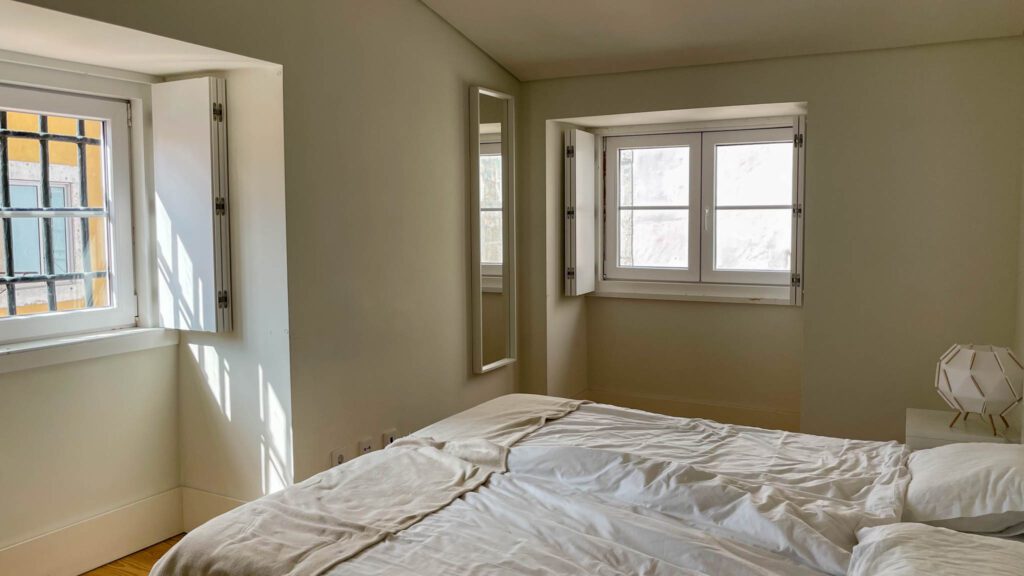
On our return trip, we stayed on the border of Baixa and Chiado a block away from Rossio Station. In our opinion, this is one of the best areas to stay in Lisbon, especially up the hill on the Chiado side.
This time, we stayed at another serviced apartment building, but they’re only available for extended stays now (and they’ve been sold a few times to different companies).
For what it’s worth, my mom went to Portugal (including Lisbon) in the fall of 2023 and, unsurprisingly, used a lot of our guides to help her plan her trip. I ended up helping her pick a place to stay – an aparthotel called 54 São Paulo – which she absolutely loved.
In fact, here’s a direct quote from her about her trip: “Hands down the best place we stayed in Portugal!”
It’s an aparthotel, which basically means it has all the amenities of a hotel (like a staffed front desk), but the benefits of having an apartment (like a kitchen and more space to spread out).
They stayed in the “penthouse” with a private terrace and loved it.
Chiado: Central and Bustling (Overall Best Location)
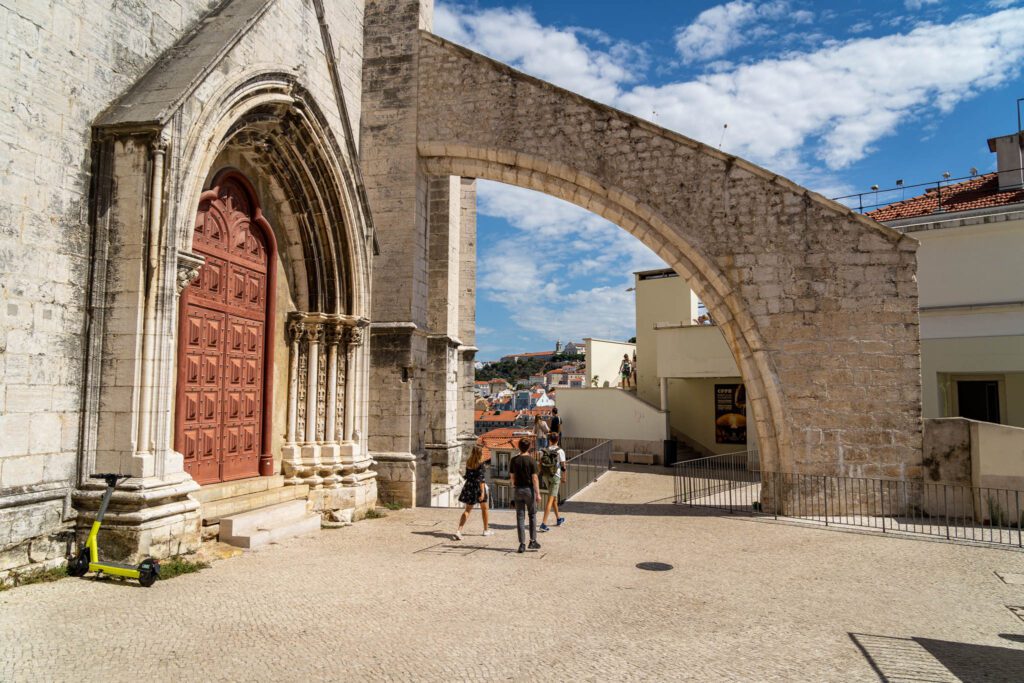
Chiado is about as central as you can get in Lisbon. It’s on the hill, which means you won’t have to walk UP the hill anytime you want to go anywhere (though you will if you head down the hill – what goes down must come back up in Lisbon).
The neighborhood itself is packed full of shopping, places to eat and drink, and historical sights like the Convento do Carmo, which is a former convent destroyed in the 1755 earthquake that is now a museum.
In many ways, Chiado is at the center of Lisbon’s history. The earthquake in 1755, which has shaped Lisbon as we know it today, and the Carnation Revolution in 1974 that ended the dictatorship in Portugal both took place in Chiado (although obviously the earthquake took place all around the city).
The architecture in Chiado is a mix of old and new, mostly due to the fire in 1988 that burned through the main shopping area around the mall. The facades remained intact (thanks to being built out of stone), but the insides were gutted and replaced.
There are a couple of ways to get up (or down) the hill from Chiado to places like Baixa or Rossio Station (which is where you catch the train to take a day trip to Sintra). You can walk, of course, which is our preferred way of getting around Lisbon.
You can take the metro. Or you can take the Elevador de Santa Justa, which was built in the early 1900’s to connect Chiado to Baixa.
Lines for the elevator are long, and it costs money. We’d recommend walking through the mall to get down (though you should definitely go to the viewing platform on top of the elevator to check out the view!).
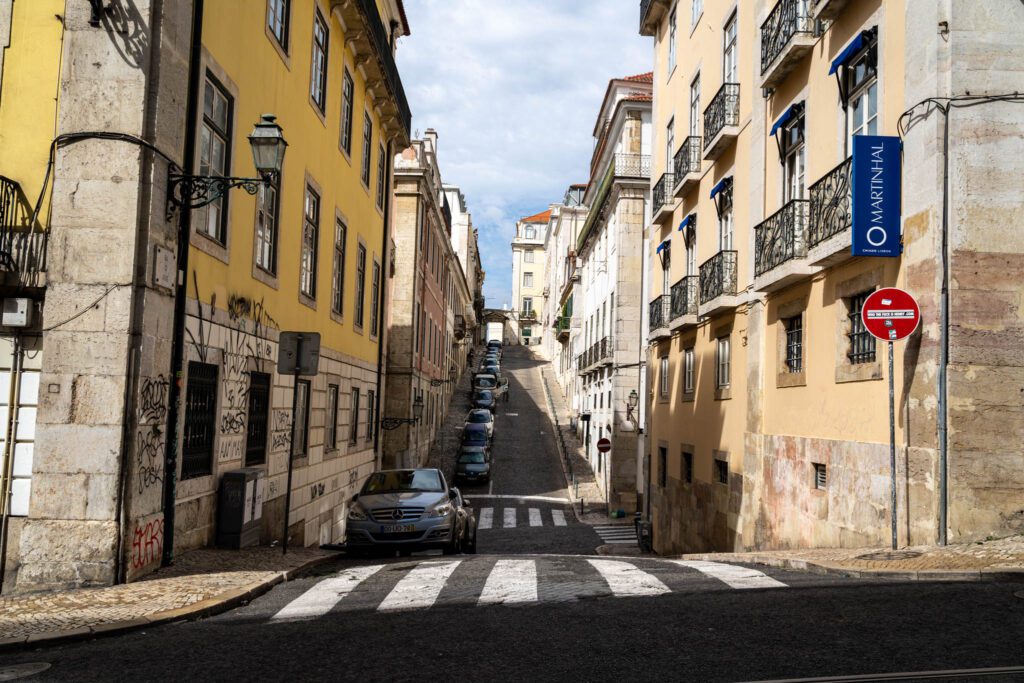
Pros and Cons of Chiado
Pros: It’s central, squished between Bairro Alto and Principe Real to the west, Alfama and Mouraria to the east, and Baixa towards the river. There’s a metro station – Baixa-Chiado – right in the heart of the neighborhood, which makes it easy to access other parts of the city. It’s more charming than adjacent Baixa, with its narrow alleys and serpentine streets providing a stark contrast to Lisbon’s downtown area, which is on a grid.
Cons: The hills, which you’ll have to walk up and down at some point, and the price are the main cons. It’s central and a very desirable area, and prices reflect that.
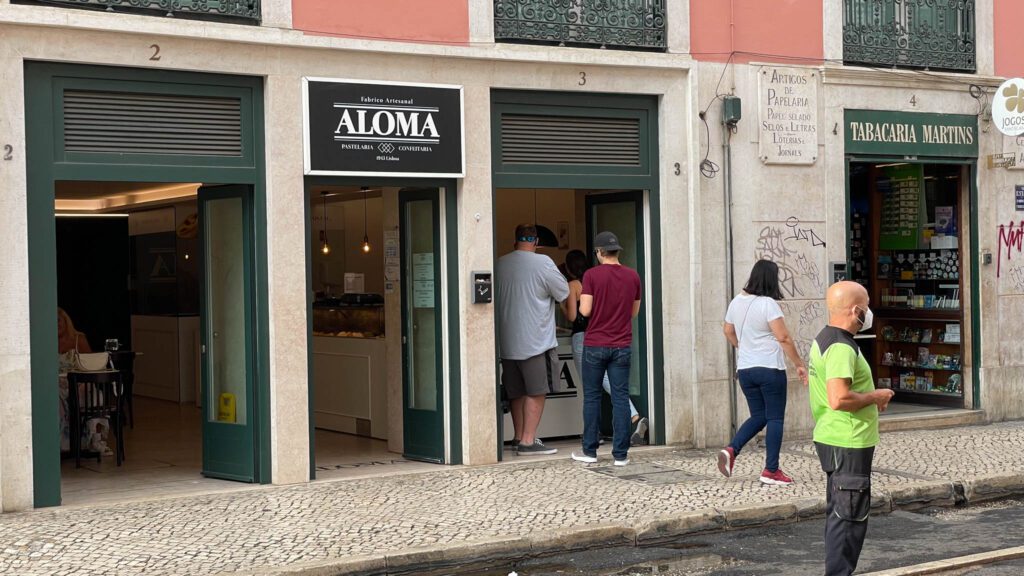
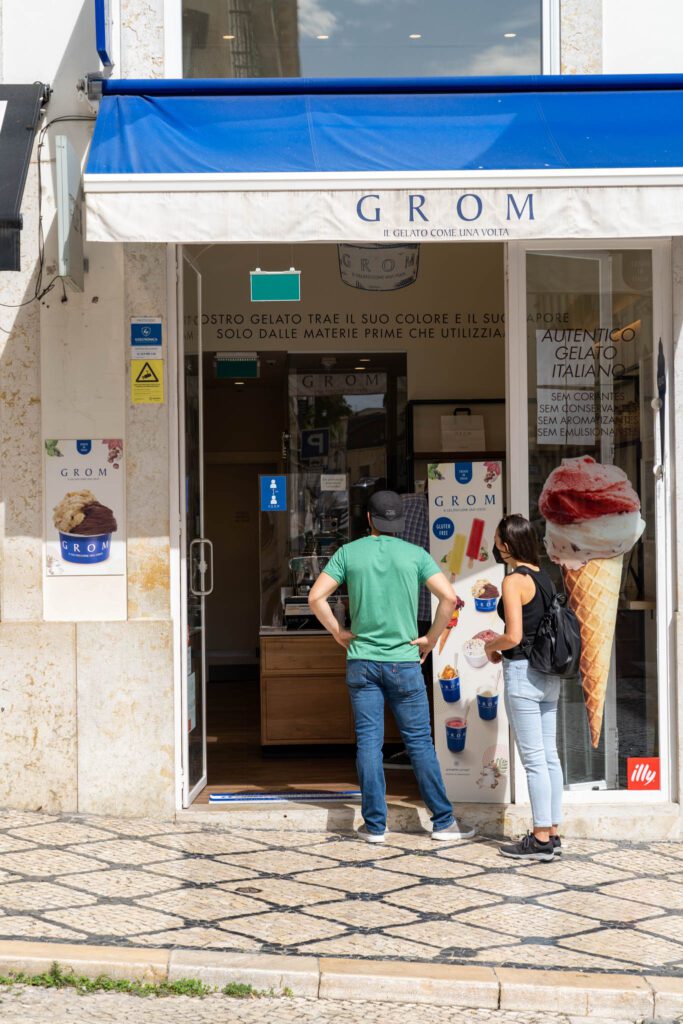

The Best Places to Stay in Chiado
Here are some of the best places to stay in Chiado, whether you’re looking for a charming hotel or a spacious apartment where you have a bit more room to spread out and relax.
There’s a lot of options in Chiado, so we’ve gone ahead and combed through hundreds of places to stay to narrow the list down to a few options that we’re excited about based on style, reviews, and location.
Feeling Chiado 15: A Boutique Hotel in an Amazing Location
This charming hotel is right on the square where you’ll find the Convento do Carmo, which might be one of Lisbon’s single best locations.
From there, you’ll be a block away from the heart of Chiado, and within walking distance of Barrio Alto, Principe Real, and Baixa.
Comfortable, spacious rooms are the name of the game here. Even the standard suites are larger than most hotel rooms you’ll find, but the deluxe suites are even bigger, some of which have a nice terrace with spectacular views of the city.
Chiado 44: A Mid-Range Guesthouse
This lovely guesthouse is a few blocks from the Baixa-Chiado metro station, which means you’ll be well-connected to the rest of the city if you decide to stay here.
The building itself dates back to the 19th Century, but the interior has been fully renovated with beautiful, stylish rooms and common spaces.
Once again, this isn’t your average mega-hotel chain. There are only 12 rooms here, which means you’re going to get personalized service.
Half of the rooms have river views and balconies, while the other half face the property’s garden (and two of those have balconies). Rooms are relatively small, but plenty comfortable if you’re planning on spending most of your time out and about exploring Lisbon.
Lost Lisbon – Chiado House: A Nice Budget-Friendly Option
This guesthouse was on our list, but the timing and dates didn’t quite work out. This is another intimate place to stay in Lisbon, with just a few rooms, exceptionally friendly service, and a beautifully decorated interior.
Your room comes with a continental breakfast, and you’ll have access to the shared kitchen to cook lunch or dinner, if you wish to. Which makes this a cross between a hostel and a hotel. They have smaller rooms outfitted with a pair of twin beds, and larger rooms that have a comfy double bed.
The decor is impeccably stylish – we love the blue tile accents throughout – and it’s worth noting that some of the rooms have private external bathrooms (rather than bathrooms inside the rooms).
The same company also has a location on Avenida da Liberdade (see it here), which is also a nice location (though not quite as central to Lisbon’s major sights).
Casa do Barao: A Nice Boutique Hotel with a Pool
I mean, this boutique hotel is in a 19th Century building that oozes charm, has a library room, and has a great outdoor pool. Plus, it’s in one of the best areas in our favorite district in Lisbon, just a short walk away from all of the action.
Unfortunately, we didn’t know about this place on our first trip, and when we went to try to book it for our return trip, they were renovating the building. So staying here didn’t quite work out for us, but that shouldn’t stop you!
It’s a hotel with just 12 rooms, so it’s more of a bed & breakfast when it comes to the service you’ll get (versus the mega hotels with 100+ rooms). The idea of a smaller, intimate hotel as a contrast to the massive hotel chains is exactly what got the owners into the hotel business in the first place.
As far as rooms go, they have a range for different budgets, from their smaller (but still pretty spacious) standard rooms, to their huge premium rooms with terraces. Breakfast is served on their lovely garden patio. And did we mention the pool?
Baixa: As Central as it Gets in Lisbon
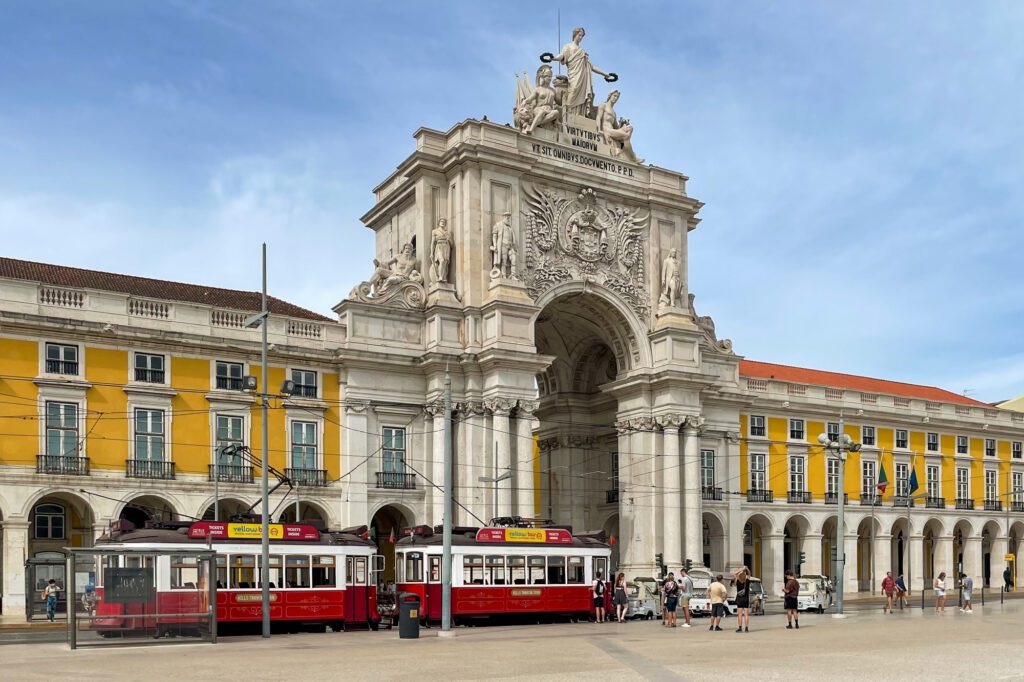
The Baixa neighborhood in Lisbon is nestled along the Tagus River between Alfama and Chiado up the hill, and the nightlife hub that is Cais de Sodre further north. It’s one of the most central – and thus “touristy” – areas in Lisbon.
After the earthquake in 1755 that led to the shaping of modern Lisbon, Baixa was rebuilt by Marquês de Pombal, who had dreams of a grid layout in downtown Lisbon.
For the most part, Baixa follows that grid layout from Praça do Comércio all the way to Rossio Train Station at it’s northern edge. It’s a stark contrast when compared to other neighborhoods in Lisbon, which generally feature narrow, winding streets and unexpected plazas.
We stayed in Baixa for our first stint in Lisbon, and it really is a perfect location for exploring the city. It’s well connected to public transportation – both via Tram 28, which basically takes you to 95% of the attractions in central Lisbon, and the metro stations along the river.
Plus, Rossio Station and Santa Apolónia Station – the two main train stations in Lisbon – are both within walking distance.
It has plenty of places to eat and drink – including the home of the best pastel de nata in Lisbon according to our unofficial taste test and the perspective of our guide on our private walking tour (we highly recommend it – it’s this tour, and you should choose Isabel as your guide if you can).
Overall, it’s a great place to stay, though we would recommend that you spend most of your day outside of Baixa exploring the less touristy and, frankly, more interesting parts of Lisbon.
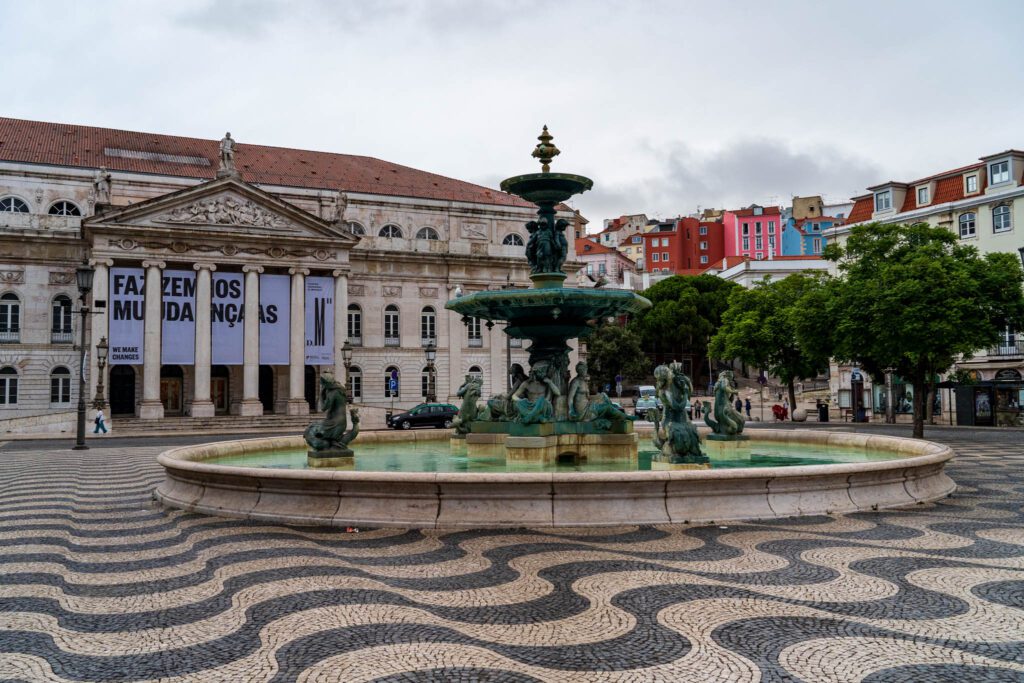
Pros and Cons of Staying in Baixa
Pros: It doesn’t get much more central. It’s well connected to public transportation. It’s flat. And you’ll be able to walk to the train station for either heading to Porto (or other parts of Portugal) and to take a day trip to Sintra, which we definitely recommend.
Cons: It’s not the most authentic area in the city, but you can just plan on spending most of your time exploring the more interesting parts of Lisbon. It’s a great location, which means it’s going to be relatively expensive compared to some of the less central neighborhoods below. It’s at the bottom of the hill, which means you’ll be heading uphill to go basically anywhere else in Lisbon. And I’d probably plan on eating elsewhere – the restaurants, particularly on Praça do Comércio, are classic tourist traps.
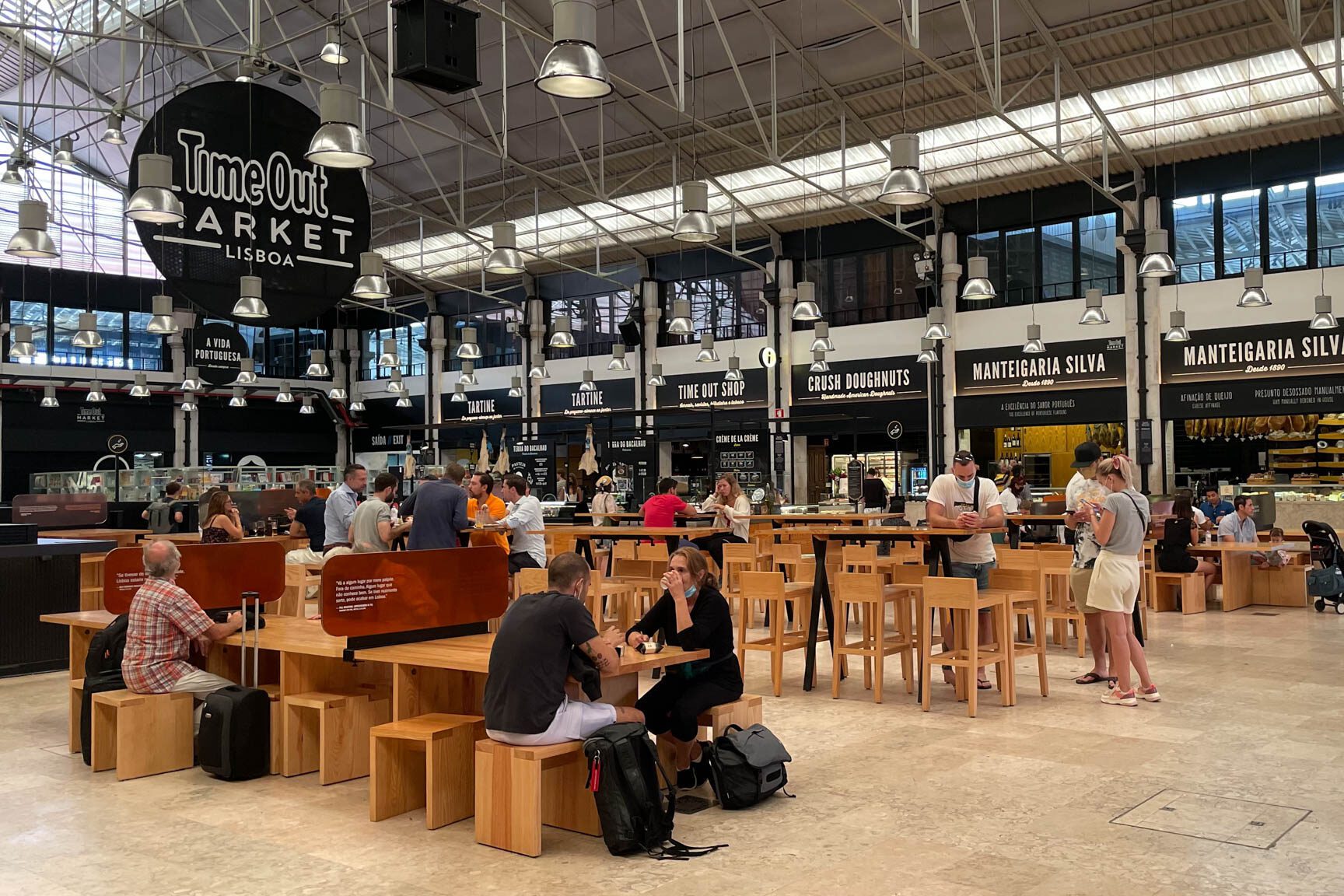
The Best Places to Stay in Baixa
Baixa has a nice mix of places to stay, mostly hotels and apartments, with a few hostels thrown in, which are perfect if you’re heading to Lisbon on a tight budget.
We went through the choices and narrowed it down to these five, which we really like.
My Story Hotel Figueira: A Stylish Boutique Hotel on a Nice Square
We walked by this charming hotel a couple of times over the course of our time in Lisbon, and every time I turned to Alysha and said something to the effect of “I need to check that place out.”
This is a Portuguese hotel chain with locations in Lisbon, Porto, and the Azores, and all of their hotels are gorgeous.
The hotel is right on Figueira Square, which is basically adjacent to Rossio Square in the heart of Baixa, central to Alfama, Chiado, the Rossio Train Station, and more.
The colorful rooms are relatively spacious (over 200 square feet!), and beds are rated as very comfortable. Some rooms have a view out onto the square (which we’d imagine comes with a little bit more noise).
They have 24 hour reception who are happy to help you with whatever you might need, breakfast, and there’s an Italian restaurant on the ground floor.
Be Poet Baixa: A Modern Mid-Range Hotel + Great Location
The location of this modern hotel is just about perfect, roughly equidistant between Alfama, Rossio Train Station, and Praça do Comércio. With that location, you’ll be able to walk or take public transportation to basically anywhere in Lisbon or beyond.
Rooms here aren’t the biggest, but they’re going to be both comfortable and affordable, which is definitely a tradeoff we’re willing to make. Decor is very modern, lacking some of the charm of older buildings that we kind of like about Lisbon, but that’s just our opinion.
Rooms are outfitted with coffee makers and reviews consistently call out the beds as super comfortable, which makes this place an excellent home base for exploring Lisbon.
Porta Do Mar: Nice, Cozy Apartments (+ Where We Stayed)
We stayed at these cozy apartments on our first stint in Lisbon, and it was a great location for getting an introduction to the city. It’s walkable to both the metro, Rossio train station (where you grab the train for a day trip to Sintra), and the tram that takes you out to Belém.
One thing you should know – the pictures look like there is a TON of natural light, and in some cases that’s probably true, but in our apartment there was only really natural light in the bedroom (which was great), while the kitchen area faced an internal courtyard with far less light going on. Not a deal breaker, just something to know.
We had a group of three, so we stayed in a split-level apartment with my little brother sleeping upstairs, and us sleeping in the bedroom. It was perfect for our particular group.
We used the kitchen to cook breakfasts, and it was stocked with everything we needed to do that.
Casas da Baixa Jules & Madeleine: Spacious Serviced Apartments for Different Group Sizes
This collection of spacious apartments is right down the street from Porta Do Mar, which means we know firsthand that it’s a solid place to stay.
The serviced apartments here – which are a cross between a hotel and an apartment building, giving you the best of both worlds – have a range of different sizes. Studios for traveling couples or pairs of friends, all the way up to two bedroom apartments with room for five.
The building is a restored 18th Century building, and the interior of the apartments are a mix of that historic character and more modern design and appliances. Rooms have small, but totally functional, kitchens, if doing some cooking is something you’re into (we are!).
They have another set of apartments – Casas da Baixa Lighthouse – just around the corner, if your dates don’t work for the other apartments.
Home Lisbon Hostel: A Family-Run, Intimate Boutique Hostel
Home Lisbon Hostel is right in the heart of Baixa, a few blocks away from the Lisbon Cathedral and the path up to Alfama, and a few blocks away from the Elevador de Santa Justa, which takes you up to Chiado.
It’s a family-run joint, which is part of the reason we picked it, which you know because they have something called “Mamma’s Dinner” where the mother of the hostel’s owner cooks a dinner full of Portuguese classics.
It’s small, at least relative to some of the other hostels in Lisbon, but we think that’s part of the charm and often leads to a better, more personal and intimate experience.
They have both private rooms and dorms (max 8 people per room) available. The private rooms are cozy and well-decorated (I love the rooms with the rich green walls and dark brown furniture), and they’re basically hotel rooms. Some even have a balcony with city views!
Nicolau, a hipster brunch-y place is right on the ground floor.
Alfama: Cobblestone Streets & Amazing Views
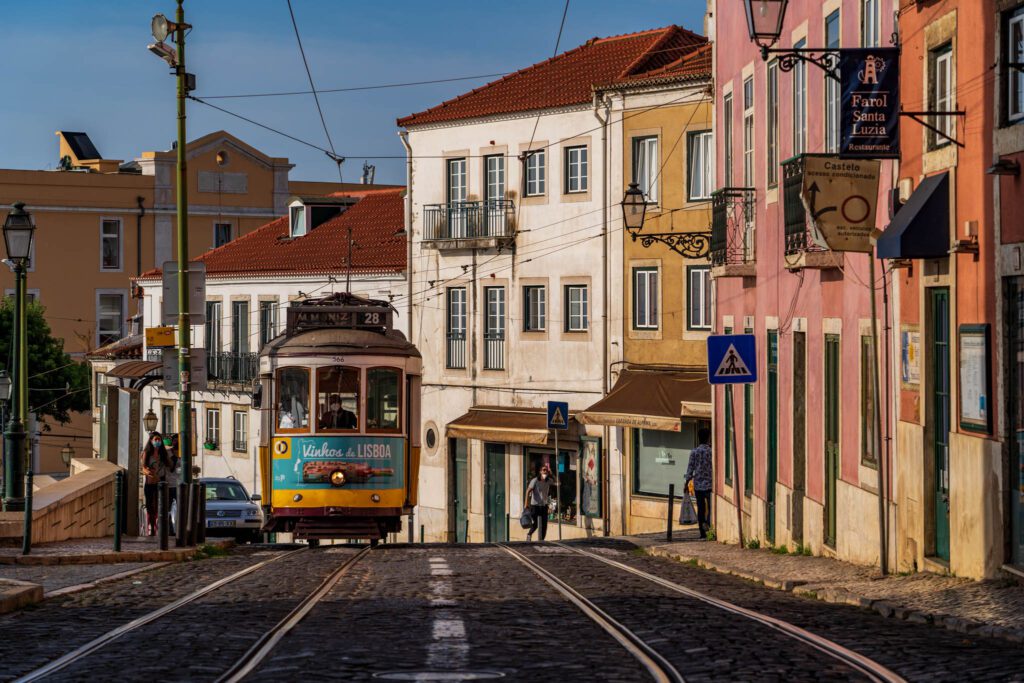
Alfama is probably the sexiest neighborhood in Lisbon. It’s charming and romantic, with it’s serpentine streets cascading down the hill from Castelo de São Jorge, and its many plazas and corners, full of people dining al fresco in the evening and with the sad-sounding melodies of fado wafting through its streets.
We found ourselves in Alfama on multiple occasions during our time in Lisbon, and it reminds me a lot of Trastevere in Rome or Montmartre in Paris, the most romantic neighborhoods in those respective cities.
Whether or not you decide to stay in Alfama, an evening stroll through the neighborhood (and possibly a dinner and some fado) should absolutely be a part of your Lisbon itinerary.
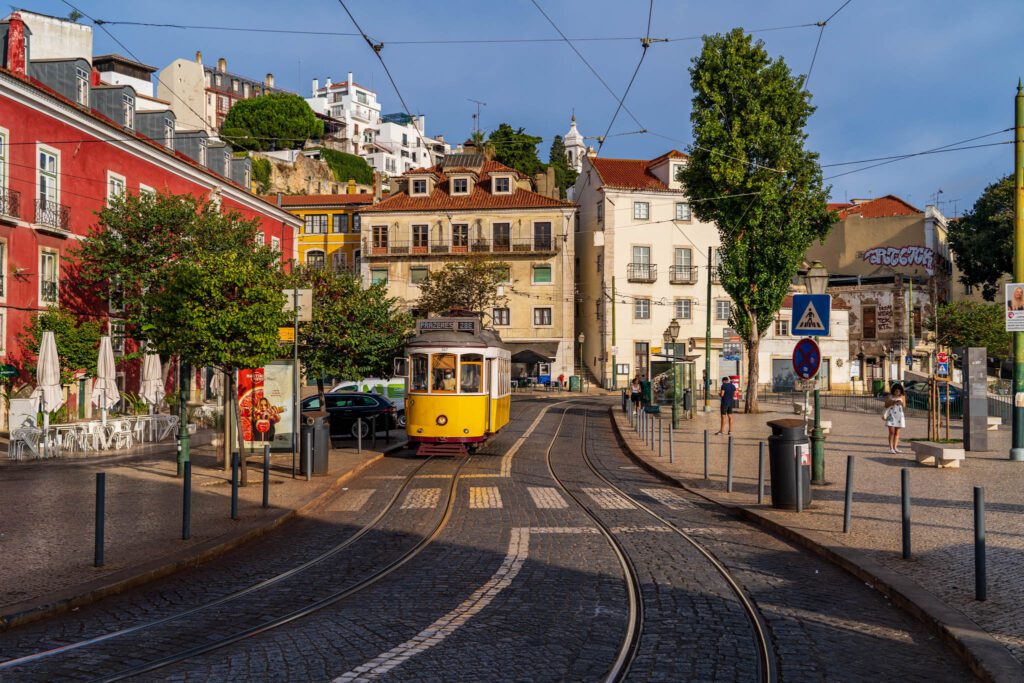
Pros and Cons of Staying in Alfama
Pros: It’s sexy. There’s something about narrow alleyways masquerading as streets and walking on cobblestones that has a certain romance, and Alfama is chock full of it. There are several fantastic viewpoints where you can look out over Lisbon (views are particularly good in the evening). And there are plenty of great bars and restaurants to be had, particularly on the northeast side of the castle.
Cons: It’s pretty easily the hardest place to access in Lisbon. Wherever you’re going, you’re likely going to either have to walk up or down a hill, or hop on the Tram 28 which is notoriously packed with tourists between 10:00 am and 5:00 pm or so.
If you try to take a taxi or Uber, good luck having them navigate those narrow streets. Again, you’re going to be walking. If walking isn’t your thing, we’d look elsewhere and plan on visiting Alfama for an evening instead. It’s also going to be fairly expensive since it’s a desirable place to stay, and there aren’t a ton of options.
There’s another con that we think is worth touching on here, and that’s gentrification. As Alfama (and Lisbon as a whole) finds itself firmly on the tourist map, more and more of the historic buildings in the area are being bought up to turn into hotels and apartments catering to the tourist demand.
Which means less inventory for locals, and higher prices, pushing people out of their homes that they’ve lived in for decades.
We’re not going to solve that problem here, but it’s worth considering as a factor when you make your decision about about where to stay. Frankly, it’s a problem throughout the entirety of the city, but it’s most pronounced in Alfama.
The Best Places to Stay in Alfama
There are a bunch of places to stay in Alfama, from upscale hotels to cozy apartments.
Lucky for you, we’ve gone through and found (read: looked at all the pictures and read reviews until our eyes were glazed over) a collection of places with great reviews that we personally like and would recommend.
Alfama is full of winding, narrow streets, which can make getting to and from your hotel a little bit of a pain. However, what it may lack in convenience it more than makes up for in atmosphere.
Here are three places to stay in Alfama that caught our eye.
Hotel Convento do Salvador
Right around the corner from one of the best viewpoints in all of Lisbon – Miradouro das Portas do Sol – is this luxurious hotel with an excellent outdoor terrace and bar.
Despite the luxurious feel, the prices are actually relatively affordable, which surprised us.
The hotel itself is built into a former convent, and is located within walking distance of the castle, a couple of really nice viewpoints, and some great bars and restaurants (do not miss the canned fish at Miss Can!).
This is an eco-friendly hotel, and I particularly like that they bottle tap water into these fancy bottles to stop people buying tons of plastic water bottles over the course of their trip.
DRINK THE TAP WATER, it’s totally safe (we drank gallons of it, and we’re still here).
Rooms are relatively small, but well thought out with modern touches. You’ll have to pay a little extra for a view of the river Tejo from your room, but you can always just head out to the terrace if you’re craving a spectacular view.
Casas do Bairro Conqvistador: Nice Apartments in Alfama
If you’re looking for an apartment in Alfama with a little more space and access to a kitchen, this would be our choice.
They have a large selection of one bedroom apartments, some with balconies, with all the bells and whistles you’ll want for your trip. Modern appliances, comfortable beds, a nice sitting area, and more.
They only have one size of apartments – one bedroom with a sofa bed that can sleep two more – which might not work for bigger groups who want to stay in the same apartment.
As we looked further into it, we realized that this complex is more than meets the eye.
It’s actually a group of different businesses – the apartments, a wine shop, a coffee shop, etc – that are owned by a single Portuguese family. You get 20% off those other businesses when you stay here, which is kind of cool.
Archi-Pelago Alfama Design Suites: Gorgeous Boutique Guesthouse
Another Portuguese-owned hotel brand, we think this gorgeous guesthouse has done a great job blending modern, minimalist style with the historic charm that makes Alfama special and romantic.
For example, the terraces that some of the rooms have has a little nook under a stone arch that looks like it was built hundreds of years ago.
In particular, we love the look of the tilework in some of the rooms and common spaces.
Rooms are minimalist in terms of design and space, but the point is that you’ll be either out exploring Lisbon, or hanging out in the common spaces rather than being locked in your room during the day.
There’s also a shared kitchen, which we appreciate because we usually cook for ourselves, at least for some meals.
Bairro Alto: For Foodies and Nightlife
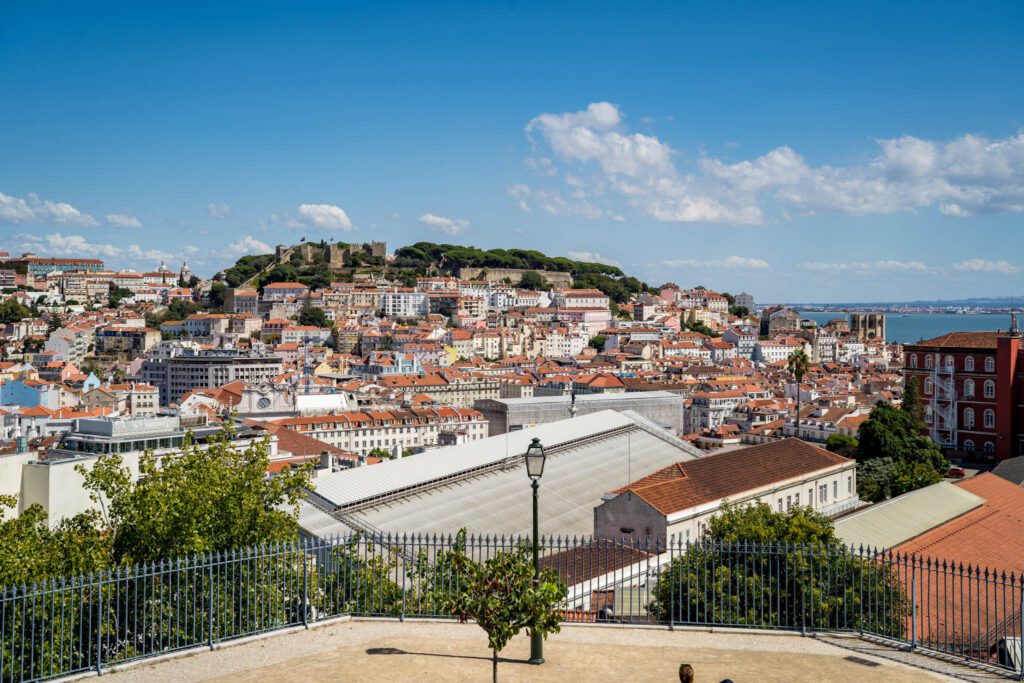
First of all, note the spelling (it’s “Bairro” not “Barrio”). Bairro Alto is immediately adjacent to Chiado, and has roots dating all the way back to the 16th Century, when the grid was first laid out and buildings started to be built.
This part of Lisbon saw fewer devastating effects from the earthquake than other parts of the city, but Pombal and the Portuguese government took the opportunity to strike when the iron was hot and modernize the infrastructure in Bairro Alto in the period where the rest of Lisbon was being rebuilt from the ground up.
Today, Bairro Alto is a nightlife hub, and is full of bars, clubs, and restaurants of all kinds.
We walked through it in the morning, when you wouldn’t know that it’s the most raucous part of the city (unless you count the broken glass bottles and the vague smell of beer).
But when you walk through after the sun sets, the area is transformed and you’ll do a double take and say to yourself “wait, is this the same street?”
Packed nearly wall to wall with tourists and locals alike who are enjoying their drinks in the middle of the street (at least in the warm and mild months…so, like, 10 months of the year?), Bairro Alto comes alive when the sun goes down.
From wine bars to speakeasy cocktail bars to nightclubs that don’t close until the early morning, you’ll find the best nightlife in the city here.
There are, of course, tradeoffs with being right in the middle of all the action. It’s loud, so don’t expect to stick to your 9:00 pm bedtime (honestly, that’s the only reason why we wouldn’t personally stay here – Matt needs his beauty sleep!).
Pros and Cons of Bairro Alto
Pros: Bars, restaurants, and clubs, oh my! No matter what kind of bar, pub, or club you’re looking for, you’ll find it in Bairro Alto. If you’re looking to stay near the nightlife so you can stumble home afterwards, this is it. It’s also far less sketchy than the other nightlife hub, Cais do Sodre, so you may get away with only being offered drugs two or three times rather than ten or more.
Cons: It’s loud. Boisterous. Debaucherous. All the things that you’d expect a nightlife area to be. If you want to get some good sleep, look elsewhere.
The Best Places to Stay in Bairro Alto
Here are a few different highly rated places to stay in Bairro Alto for different budgets and travel styles. We’ve done the hard work of combing through hundreds of places to stay to find a few that we, personally, like and would stay at in Bairro Alto on one of our next trips to Lisbon.
Stylish Hotel: Casa das Janelas com Vista
Style on a Budget (Boutique Hostel): The Independente Hostel and Suites
Spacious Apartments: Bairro Alto Bronze of Art Apartments
Bed & Breakfast: Dear Lisbon – Charming House
Where NOT to Stay in Lisbon
In general, we’d recommend staying near the city center, particularly if you have a short trip (4 days or less).
That way, you’ll be within walking distance (or public transportation, but Lisbon is an awesome walking city despite the hills) of most of the main attractions in Lisbon.
That means you should immediately cross off anything further north than Rua do Salitre (ish), which is at the northern edge of Principe Real, anything east of Alfama, and anything further west than Principe Real.
Within that area, you’ll have plenty of choice in terms of places to stay, whether you’re looking for a quiet, more residential neighborhood, or a hip area with good nightlife. Or just about anything in between.
We would avoid Cais de Sodre, which is the area immediately around the Time Out Market closest to the river.
While we walked through the area at all times of day and felt perfectly safe, it was the place where we were offered drugs the most often.
Like, every block. At least once per block.
It’s a good place to spend an evening eating and drinking to your heart’s content, full of bars and restaurants, but we’d recommend staying elsewhere if you can.
Planning a trip to Portugal?
Here are our other Portugal travel guides to help you plan an incredible trip (even if you have to eat gluten free!).
If there’s no link below, it means we’re still working on it – long, in-depth guides take time! We’re working on it, though, we promise.
Portugal:
Lisbon
- 25 Incredible Things to Do in Lisbon: A Complete Guide
- 3 Days in Lisbon: Planning the Perfect Lisbon Itinerary
- One Day in Lisbon: The Best of Lisbon in 24 Hours
- Gluten Free Lisbon: A Complete Guide to Lisbon’s Best Gluten Free Restaurants
- The Best Coffee in Lisbon: 9 Amazing Lisbon Coffee Shops to Add to Your List
Porto:
- 3 Days in Porto: Planning the Perfect Porto Itinerary
- One Day in Porto: How to See the Best of Porto in a Day
- Where to Stay in Porto, Portugal: The 3 Best Places to Stay
The Algarve:

Such great detail and ideas. Will keep your list of gf handy when we travel to Portugal summer ‘24
Thanks Sheryl! Glad you found it helpful. Let us know as you get closer if you have any questions – always happy to help.